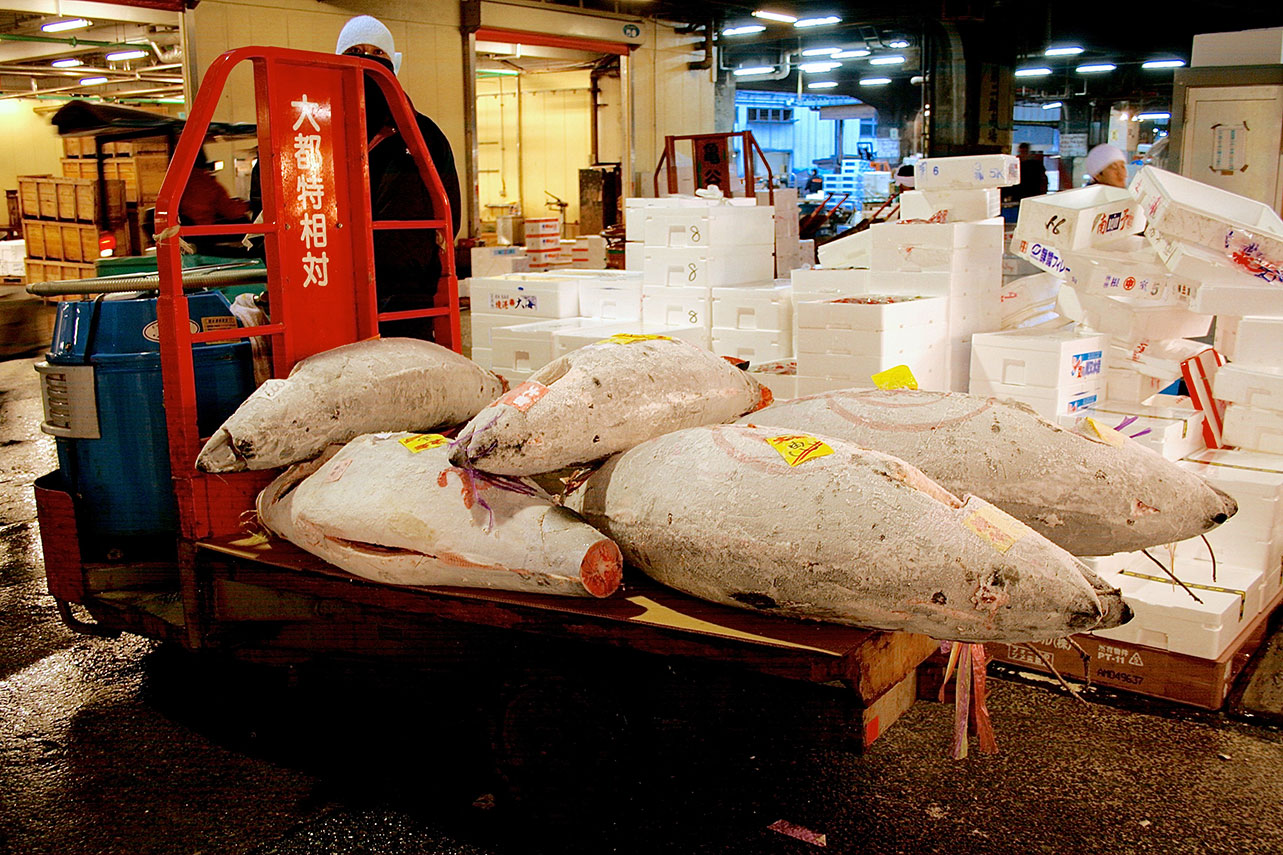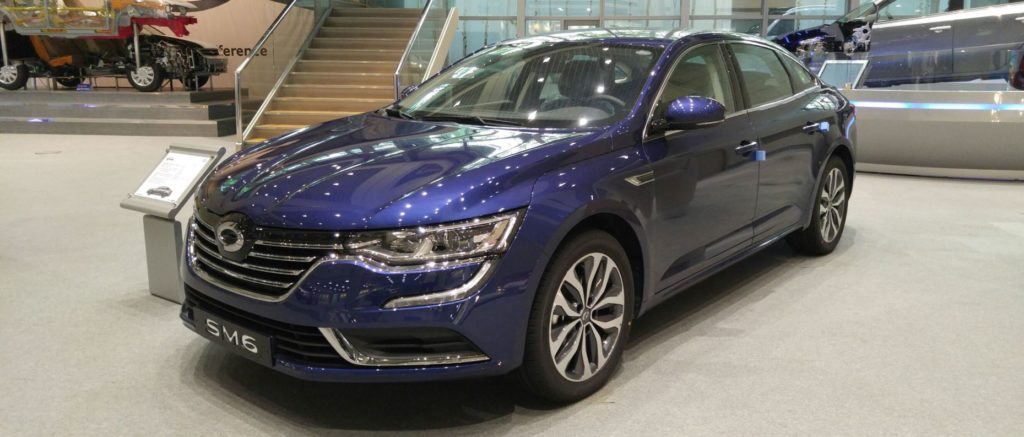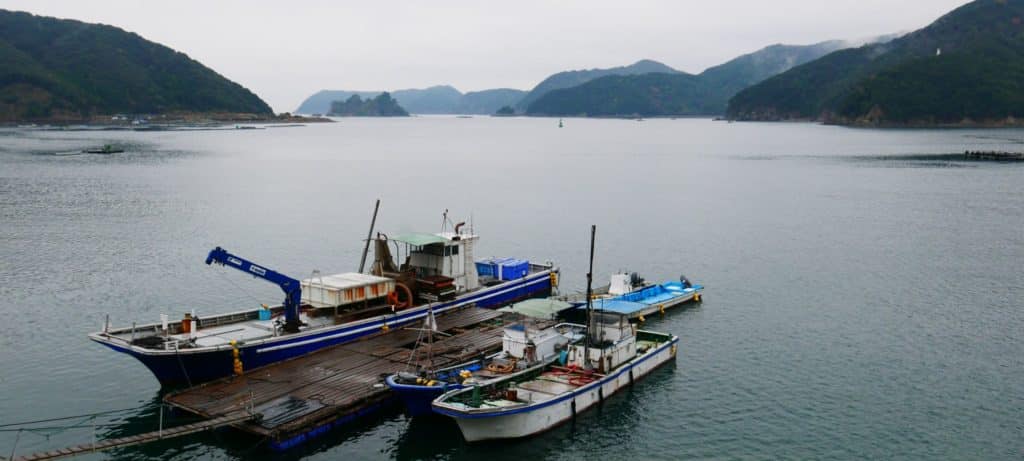
Tuna Auction
[dropcap type=”full” ]D[/dropcap]awn was a privilege I couldn’t afford. To discover the full Tsukiji experience, one had to reach the market at 4 in the morning and queue up for the tuna auction. Only 120 visitors would be allowed to observe the auction in two batches of 60. At the Osakana Fukyu Center (Fish Information Center), next to the Kachidoki Gate (northeast corner of Tsukiji), there were already 10 people in queue. After handing out instruction pamphlets, the queue was segregated into two groups and given two different colored vests – yellow for the first entrees, blue for the next.
Soon the gates opened and we were ushered into a nondescript hall, looking much like the interior of a cargo container. Us spectators were collected in a corner, facing the tuna, already on the ground, laid out in neat rows. Prospective buyers with small scythe-looking “fish picks” prodded at the frozen carcasses, examining the flesh and what I assumed (being an avid sushi foodie) was the much-valued fat content within it.
After the inspection, the auctioneer rang off a bell and the sale of tuna was underway. A flurry of hand movements (some hips were into the action too), alien to me, began. An imagined beat pumped in my head as the middle aged Japanese men, some bespectacled, in fleeced cardigans and nylon pants performed a パラパラ(Para Para) dance.
The sell-off went by in a flash, perhaps because I was held entranced by the ritual, or perhaps because I hadn’t fully woken up yet.
Returning the vest, I made my way to the warehouse area. From outside, turret buggies pulling giant fish zipped in as the sun, lazing still below the horizon, refused to rise.
[photogrid ids=”777,774,781″ captions=”yes” columns=”three” fullwidth=”yes” ]
The Fish Market Warehouse
The warehouse market was a treasure trove of sea monsters. An array of your usual market type fish – only bigger, mixed in with oddities, miniaturized versions of Ultraman nemesis with a dash of Godzilla.
An encampment of styrofoam boxes stacked around trays of a briny water, keeping the freshest seafood alive. Behind them, owners entrenched in petite cubicles tapped furiously on calculators, scribbling numbers into account books. Forklifts and trolleys ran industrious along corridors, on their backs the frozen log of a Bluefin tuna. Bulbs of octopus, curled like flower buds and strings of eel interweaved together. Giant scallops, fuller than a face and geo-ducks the length of my leg. Seafood Paradise! And at wholesale prices too, a punnet of Uni (Sea Urchin) started as low as 750yen.
Tsukiji wasn’t just for seafood. There was a warehouse for fruits and vegetables too, and an outer market with sushi stalls. Knives and utility stores and I even spotted a store selling Tamago. Rows and rows of delightful yellow egg rolls, sweet and salty.
[photogrid ids=”778,780,779″ captions=”yes” columns=”three” fullwidth=”yes” ]
Sushi Bar and Fugu
I wandered into a Sushi bar, a meager shop with a counter and bar stools. Behind the counter, stood a lone sushi chef. I declined a menu and had my meal omakase. He shaped them as I ate them one by one. I finished off with a fugu sushi. It was my first time eating puffer fish. Its taste was unremarkable, but the spongy yet melt-in-your-mouth texture was intriguing.
As I walked through the gates of Tsukiji, Tokyo had already stirred to life. Heading for the subway that had finally awoken, the throngs of morning shoppers streamed passed me, in the opposite direction. I was headed back to my hotel, satiated and ready for a mid-morning nap.
[photogrid ids=”784,783,782″ captions=”yes” columns=”six” fullwidth=”yes” ]
Information:
Open
Outer Market: Varies by shop, typically 5:00am to 2:00pm
Wholesale Area: Open to visitors after 9:00am
Tuna Auction: Open to visitors from 5:25am to 6:15am (restricted to 120 visitors/day). Go to the northeast corner, Kachidoki gate and look for the Osakana Fukyu Center (Fish Information Center). I recommend going earlier as the queue always exceeds the admittance quota.
Closed
Sundays, National Holidays and some Wednesdays (see “English Links” below).
The tuna auction gets closed to tourists for a few weeks over New Year (usually from early December to mid January; December 1, 2014 to January 17, 2015) to ensure a smooth and accident free course of business during that busy time of the year.
Subway
Tsukiji Market is just above Tsukiji Shijo Station on the Oedo Subway Line. Alternatively, it can be reached in a five minute walk from Tsukiji Station on the Hibiya Subway Line. The closest JR station is Shimbashi, from where you can walk to the market in about 15 minutes.
If you want to catch the Tuna Auction, you want to be there around 4am. The subway starts at around 5am so your only option is for a hotel transfer or grab a taxi.
- Nice, The French Riviera, France - November 11, 2015
- The Tsukiji Fish Market Tuna Auction Experience - October 25, 2015
- The Sandstone Peaks of Meteora (Greece) - September 28, 2015


